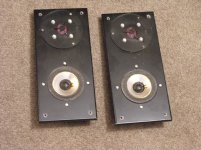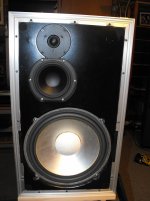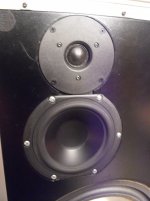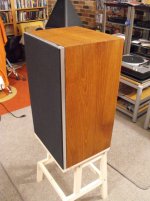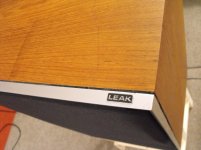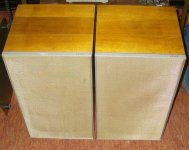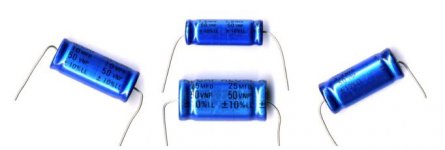I recently got around to fixing up a pair of Leak 600 speakers from the early ‘70’s. They had been sitting in storage for about 5 years, since I bought them, basically for the 12” sandwich woofers, which were ahead of their time. My brother had a pair in the 70’s and I was always impressed by the way they reproduced bass. Very tight and punchy for a moderate sized box (estimated 60 liters = 2 cu ft). My brother was a semi-pro drummer at the time, so he liked realistic bass. The mid-range and treble were nothing special and the way they were mounted side-by-side, stereo imaging was never their strong point. My plan was to replace the mid-range and tweeter with good modern equivalents and reconfigure the baffle to have mid-range and tweeter in a vertical line. I found that the 5” Peerless HDS P830860 drivers are a perfect fit for the existing cardboard tube mid enclosure. The old treble cut-out was blocked up flush and a new cut-out above the mid opening was made for a Vifa DT27TG-35-06. I know these drivers well and like their performance. The caps in the crossover were replaced just in case (they were over 40 years old!) and I tested the level matching with my Behringer RTA. The frequency response was flatter than with the original drivers, so no padding down of levels was necessary. Now I got a bit creative. The mid and tweeter sharing the same baffle as a 12” woofer is not an attractive idea. Usually this requires a really solid and braced baffle. In the original 2-way Leak sandwich speaker, the tweeter was mounted to the grille to isolate it from the woofer vibrations. Also the woofer magnet was tensioned up against the rear of the speaker by a treaded rod. Taken with the bituminous damped ½” plywood box, and the sandwich woofer, Leak were ahead of their time in many regards. However for the Leak 600 the threaded brace is dropped but a solid hardwood 2”x2” brace connects the baffle to the rear. In the spirit of the original idea, I wanted to partially isolate the mid and tweeter from the woofer by not mounting them to the same baffle. So glued a super-baffle with an enlarged woofer cut-out to the original chipboard baffle. The woofer mounts to the original (inside) baffle with the same mounting holes and the mid and tweeter mount to the super (outside) baffle. The two baffles are glued together by a 3 mm thick layer of adhesive damping compound (Bostik V60 glazing silicone). This is my attempt at a constrained layer damped baffle. The mounting screws for mid and tweeter do not penetrate into the inner baffle as this would provide a transmission path for unwanted woofer vibrations to affect the other drivers. The 3mm layer of silicone can be seen between the ply box and aluminium trim. New grille cloth and Velcro fixing complete the project. The level of vibration on the mid-tweeter baffle is noticeably less than on the rest of the box. I am ecstatic over the results. I consider that I have improved a flawed classic, while preserving the still excellent external cosmetic condition. The cheapo stands are modified IKEA Bekvam stools.
BEKVÄM Step stool - beech - IKEA
They are a perfect height but not they last word in rigidity. These speakers must be listened to on axis.
BEKVÄM Step stool - beech - IKEA
They are a perfect height but not they last word in rigidity. These speakers must be listened to on axis.
Attachments
Nice job...you have to be a bit of a vintage nut to spend this kind of time, effort and money on speakers like this (I speak from experience)
Sterling move to replace the original HF and Mid unit...typical mediocre Rank-Wharfedale quality from the 70s.
Had a pair of these myself late 60s version however, but luckily the LF units were solid. As I recall the HF and MF drivers were slightly different than yours but the sandwich LF unit was definitely the same driver.
Never got around to tarting them up as a Leak fanatic kept badgering me to part with them. Liked the cabs and grills and as memory serves they seemed to like being mated to SE amps...for some reason I can't find any pics of mine sans grills...
Good work!
Sterling move to replace the original HF and Mid unit...typical mediocre Rank-Wharfedale quality from the 70s.
Had a pair of these myself late 60s version however, but luckily the LF units were solid. As I recall the HF and MF drivers were slightly different than yours but the sandwich LF unit was definitely the same driver.
Never got around to tarting them up as a Leak fanatic kept badgering me to part with them. Liked the cabs and grills and as memory serves they seemed to like being mated to SE amps...for some reason I can't find any pics of mine sans grills...
Good work!
Attachments
Last edited:
Leak used a variety of mids and tweeters, none of which did the speaker any favours.As I recall the HF and MF drivers were slightly different than yours but the sandwich LF unit was definitely the same driver.
Maybe that's because you never managed to remove the grilles!! They are incredibly tight fitting. My fingernails won't do it. I needed a sharp pry tool and still managed to leave slight marks on the metal trim. I've seen lots of questions on how to remove the grilles. My advice is use a stiff pick and start at the bottom to minimise visibility of marks (inevitable)....for some reason I can't find any pics of mine sans grills...
Maybe that's because you never managed to remove the grilles!! They are incredibly tight fitting. My fingernails won't do it. I needed a sharp pry tool and still managed to leave slight marks on the metal trim. I've seen lots of questions on how to remove the grilles. My advice is use a stiff pick and start at the bottom to minimise visibility of marks (inevitable).
Nope. I managed to remove them...this iteration of Leaks had four tiny set screws on the vertical planes of the frames, that once loosened allowed easy access to the drivers.
I've got a pair of the earlier mini sandwich 's the 8 ohm variant, I always liked their retro looks and wonderful vynair grilles, they are the ones with the distinctly handmade look once you get the cover off and the big oval bass/ mid unit which in spite of its size is very limited in depth, very well made rigid cabs though...
The lack of bass I can deal with, at least what is there is tight to full modern standards but they are also hideously bright, ive often wondered about changing the very crude cone tweeter in them, wonder if anyone has any thoughts?
The lack of bass I can deal with, at least what is there is tight to full modern standards but they are also hideously bright, ive often wondered about changing the very crude cone tweeter in them, wonder if anyone has any thoughts?
Ah, Vynair and Tygan are names from the past. I'm not so fond of what they do for the sound though. I much prefer the very fine weave replacement polyester fabric that I used. The older fabric did provide a better sense of protection for the delicate tweeters though.I always liked their retro looks and wonderful vynair grilles
The lack of bass I can deal with, at least what is there is tight to full modern standards
I've never listened to the 8" versions but the 12" drivers in a sealed box are as good as any modern driver I have used. The power handling may be a bit limited but at sensible levels they are nicely tight and detailed, especially on acoustic bass.
I have had good results with quite a few different Peerless tweeters, also SB.they are also hideously bright, ive often wondered about changing the very crude cone tweeter in them, wonder if anyone has any thoughts?
It depends on where you crossover which are most suitable. With an 8" mid/woofer I would expect the x-over point will be quite low for the tweeter, maybe 1-2 kHz. This restricts the power handling of the tweeter and requires a low Fs tweeter, about 650Hz is the best available. Another issue is that a crossover point of 1-2 kHz is high for the 8" woofer. The sandwich woofers usually have severe break-up modes outside of their most effective pass-band and need steep filter slopes or sometimes notch filters, to suppress their audibility. Overall, it might be a challenging project to modify these speakers.
Ah, Vynair and Tygan are names from the past. I'm not so fond of what they do for the sound though. I much prefer the very fine weave replacement polyester fabric that I used. The older fabric did provide a better sense of protection for the delicate tweeters though.
I'd agree normally of course but in the case of these I doubt a direct meteor strike would do the tweeters a lot of damage
I've never listened to the 8" versions but the 12" drivers in a sealed box are as good as any modern driver I have used. The power handling may be a bit limited but at sensible levels they are nicely tight and detailed, especially on acoustic bass.
They do have limited power handling but that's fine with most partnering equipment of the period, these though have something like a 13x8" oval bass unit (they are in the loft right now and I'm too lazy to go up and measure them) but in what's a really small box for the size of the driver. Hence I suppose the limited bass depth. They are very definitely 'bookshelf' speakers..
I have had good results with quite a few different Peerless tweeters, also SB.
It depends on where you crossover which are most suitable. With an 8" mid/woofer I would expect the x-over point will be quite low for the tweeter, maybe 1-2 kHz. This restricts the power handling of the tweeter and requires a low Fs tweeter, about 650Hz is the best available. Another issue is that a crossover point of 1-2 kHz is high for the 8" woofer. The sandwich woofers usually have severe break-up modes outside of their most effective pass-band and need steep filter slopes or sometimes notch filters, to suppress their audibility. Overall, it might be a challenging project to modify these speakers.
It would indeed and if I'm honest probably not worth the bother though where would the fun be if we only ever did things that were worth it?!
I do take your point though about breakup modes, that may indeed be a lot of the problem here and it would all have to be done by sheer guesswork.. I wonder though if maybe a decent full range but brought in high, say 500-750hz might not work wonders. Perhaps one of the metal coned ones..

Hoping for some advice on Leak 600 speakers
Hi all,
I just came across this thread whilst looking up Leak 600 Speakers of which I own a pair. I was hoping for some of your advice as I am a complete beginner at fixing speakers. Bon, it looks like you did a great job on your Leaks!
The problem I am having is that one cabinet is putting out less signal than the other. My right speaker cabinet sounds great unfortunately the left cabinet is quieter. I have checked it on two different amps and swapped channels on both so I know it is the speakers. I have opened it up and taken some pictures to show you. Not that one could probably tell just by looking but I was hoping for some advice as to what to potentially check or replace. Unfortunately, I'm not as skilled as you Bon so I'm going to have to keep the speakers that came with it for now. Thou that would be a great project.
I was also wondering if it was standard to have the insulation in the cabinet (see photo of white woollen material)
Thanks very much in advance
Hi all,
I just came across this thread whilst looking up Leak 600 Speakers of which I own a pair. I was hoping for some of your advice as I am a complete beginner at fixing speakers. Bon, it looks like you did a great job on your Leaks!
The problem I am having is that one cabinet is putting out less signal than the other. My right speaker cabinet sounds great unfortunately the left cabinet is quieter. I have checked it on two different amps and swapped channels on both so I know it is the speakers. I have opened it up and taken some pictures to show you. Not that one could probably tell just by looking but I was hoping for some advice as to what to potentially check or replace. Unfortunately, I'm not as skilled as you Bon so I'm going to have to keep the speakers that came with it for now. Thou that would be a great project.
I was also wondering if it was standard to have the insulation in the cabinet (see photo of white woollen material)
Thanks very much in advance
An externally hosted image should be here but it was not working when we last tested it.
An externally hosted image should be here but it was not working when we last tested it.
An externally hosted image should be here but it was not working when we last tested it.
An externally hosted image should be here but it was not working when we last tested it.
An externally hosted image should be here but it was not working when we last tested it.
An externally hosted image should be here but it was not working when we last tested it.
The white wadding is an essential feature to absorb box resonance and avoid a hollow sound, just keep it away from the drivers. The cabinet panels are damped by the stick-on absorbtion sheets which is quite high end. Adding extra hardwood battens actually makes the sound worse, and is not recommended.
A speaker of this vintage will have Elcap 50V non-polar electrolytics, which will dry out with age and cause the loss of level which you are experiencing. Not expensive to replace with the ALCAP equivalents pictured below. Keep a note of wiring polarity if you have to disassemble, but a soldering iron and a solder sucker and modern lead-free solder is required. Get in and out quickly, suck out the old lead solder and redo, say 5 seconds to avoid cooking the new capacitors.
You could replace the (3-4uF?) tweeter capacitors with modern polypropylenes, but the rest are voiced for the original electrolytic type and perhaps best left as such. Happy listening.
A speaker of this vintage will have Elcap 50V non-polar electrolytics, which will dry out with age and cause the loss of level which you are experiencing. Not expensive to replace with the ALCAP equivalents pictured below. Keep a note of wiring polarity if you have to disassemble, but a soldering iron and a solder sucker and modern lead-free solder is required. Get in and out quickly, suck out the old lead solder and redo, say 5 seconds to avoid cooking the new capacitors.
You could replace the (3-4uF?) tweeter capacitors with modern polypropylenes, but the rest are voiced for the original electrolytic type and perhaps best left as such. Happy listening.
Attachments
I'd agree with all the above (those Elcaps will need changing) except the 'modern lead free solder'. That stuff is a nightmare to use even for those used to soldering it needs loads more heat which isnt a great idea with antique electronics and the lead free EU rule does not apply to apply to non commercial use...
Do yourself a favour and use proper 63/37 solder
All the best
Do yourself a favour and use proper 63/37 solder
All the best
I just got back to this page and can see that you have been given good advice in my absence. The first thing I did was replace the Elcaps in the crossover. I can go into more detail on how I replaced the mid and tweeter. I just happened to have a bunch of nice drivers sitting around and they fitted like a glove (with some persuasion). If your drivers are all ok, then happy listening.Thanks so much for your replies guys. I really appreciate it!!
Cheers
I just got back to this page and can see that you have been given good advice in my absence. The first thing I did was replace the Elcaps in the crossover. I can go into more detail on how I replaced the mid and tweeter. I just happened to have a bunch of nice drivers sitting around and they fitted like a glove (with some persuasion). If your drivers are all ok, then happy listening.
Hi Bon,
Thanks so much for your reply. Unfortunately I have been held up on this project with other work so sorry for my slow reply. To be honest I'm really not very skilled with this kind of work but can't afford to get them fixed elsewhere so I am trying to work it out.
Do you know the exact values and type of capacitors I need to order? Is the crossover ALCAP 50V? I'm just not sure which cap is for which. I went to my local electronics shop, showed them a photo and asked for the Alcaps and they said they don't stock them. So I just want to find out the right type and order them online. I was also wondering if the board with the caps and crossover etc should be easy to take out, I tried pulling it out but didn't want to break it?
Eventually I'd love to replace the mid and the tweeter but for now I just want to get them working.
Please excuse my basic questions and thanks everyone for your time and help.
I don't have access to the speakers anymore, having passed them on.Do you know the exact values and type of capacitors I need to order? Is the crossover ALCAP 50V? I'm just not sure which cap is for which.
I used the non-polar electrolytics from Jaycar. The values are printed on the original elcaps. I had to use the closest available value in a couple of cases. They were a lime green colour.So I just want to find out the right type and order them online.
I clipped out the elcaps and soldered the replacements with the board in place. It is tight but do-able without burning yourself.I was also wondering if the board with the caps and crossover etc should be easy to take out, I tried pulling it out but didn't want to break it?
Leak Sandwich grills and the Cadbury secret
I have inherited some 3-way 600's that need repair. ( something loose inside )
Is it required to cut through the grill cloth first to expose these screws? Being in the machine trade, I tried fitting multiple steel rule strips around the metal frames of the grill before prying to prevent damage to the wood. Something is holding this frame fast from the inside as the grills will not come off. Can't visualize how they were installed in the first place. Thanks to all for reading.
Nope. I managed to remove them...this iteration of Leaks had four tiny set screws on the vertical planes of the frames, that once loosened allowed easy access to the drivers.
I have inherited some 3-way 600's that need repair. ( something loose inside )
Is it required to cut through the grill cloth first to expose these screws? Being in the machine trade, I tried fitting multiple steel rule strips around the metal frames of the grill before prying to prevent damage to the wood. Something is holding this frame fast from the inside as the grills will not come off. Can't visualize how they were installed in the first place. Thanks to all for reading.
I've just solved my problem. My only solace is that it will be archived for future generations.
The metal frames are screwed to the cabinet. It is a simple thing to gently pry the grill cloth (which is wrapped around some greenboard) out of the frame. All is revealed after that. Now I can concentrate on all the great information that has gone before on this thread.
The metal frames are screwed to the cabinet. It is a simple thing to gently pry the grill cloth (which is wrapped around some greenboard) out of the frame. All is revealed after that. Now I can concentrate on all the great information that has gone before on this thread.
Hello, I just found two Leak 600's near my dumpster here in the Chicago area. Didn't know what I really had. I see the mid-range has been replaced with a no name unit. But the magnet is quite large. The woofers have been replaced with the recommended Peerless units. So someone has done the work for me already! I am missing one of the grills, but have the other original. I have hooked it up to a Hybrid 25 watt tube amp, and they sound good to me!
Needing advice on speaker connections
I just got a pair of these Leak 600 speakers in amazing condition but am having issues with the way the speaker wires attach to back of speakers. I should preface that I am a novice at best in the vintage stereo equipment arena. The issue I am having is with the banana plug adapter which has the different sized barrels that slip onto the speaker nodes. I get them all hooked up and it sounds great but within minutes or in moving the speakers to desired location the connections are lost and i just get a distorted fuzzy lower volume sound. I have tried to clean the adapters and nodes with contact cleaner and emory paper but with no luck. I am curious if anyone has any ideas on how to circumvent these issues with a different connection setup or if anyone knows of a place I could find new adapters. Thank you all in advance for any help or advice!
I just got a pair of these Leak 600 speakers in amazing condition but am having issues with the way the speaker wires attach to back of speakers. I should preface that I am a novice at best in the vintage stereo equipment arena. The issue I am having is with the banana plug adapter which has the different sized barrels that slip onto the speaker nodes. I get them all hooked up and it sounds great but within minutes or in moving the speakers to desired location the connections are lost and i just get a distorted fuzzy lower volume sound. I have tried to clean the adapters and nodes with contact cleaner and emory paper but with no luck. I am curious if anyone has any ideas on how to circumvent these issues with a different connection setup or if anyone knows of a place I could find new adapters. Thank you all in advance for any help or advice!
- Home
- Loudspeakers
- Multi-Way
- Leak Sandwich 600 project
